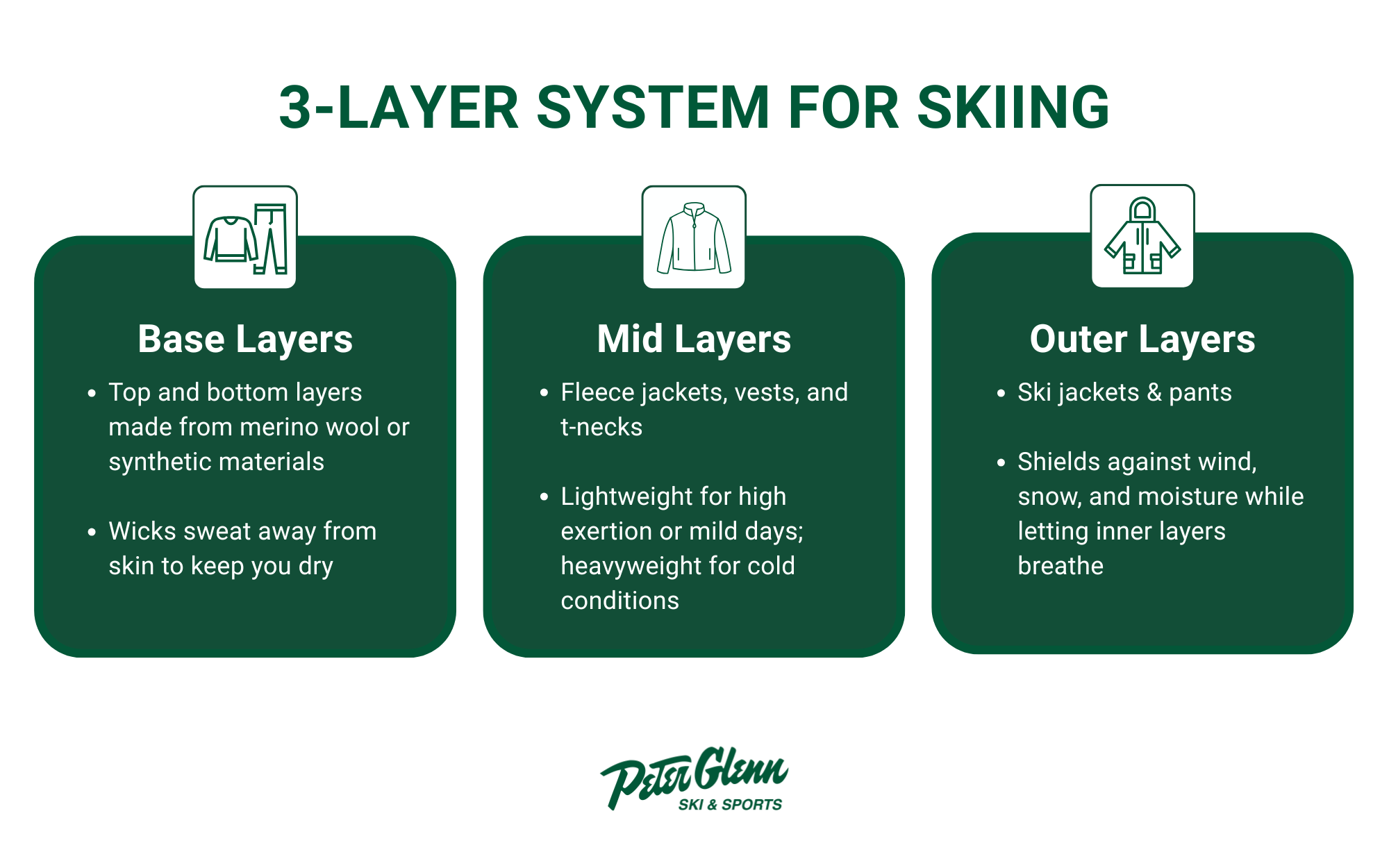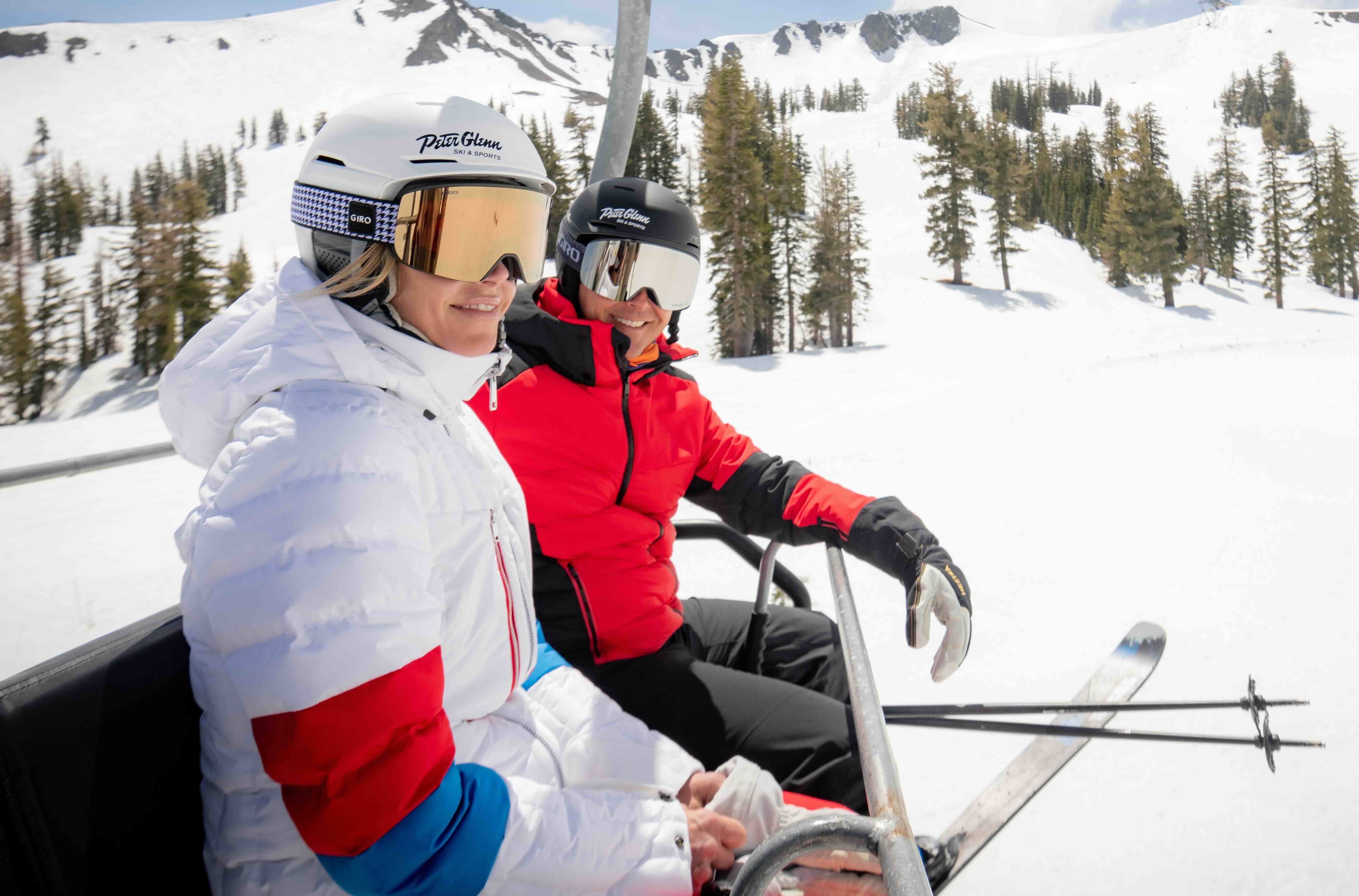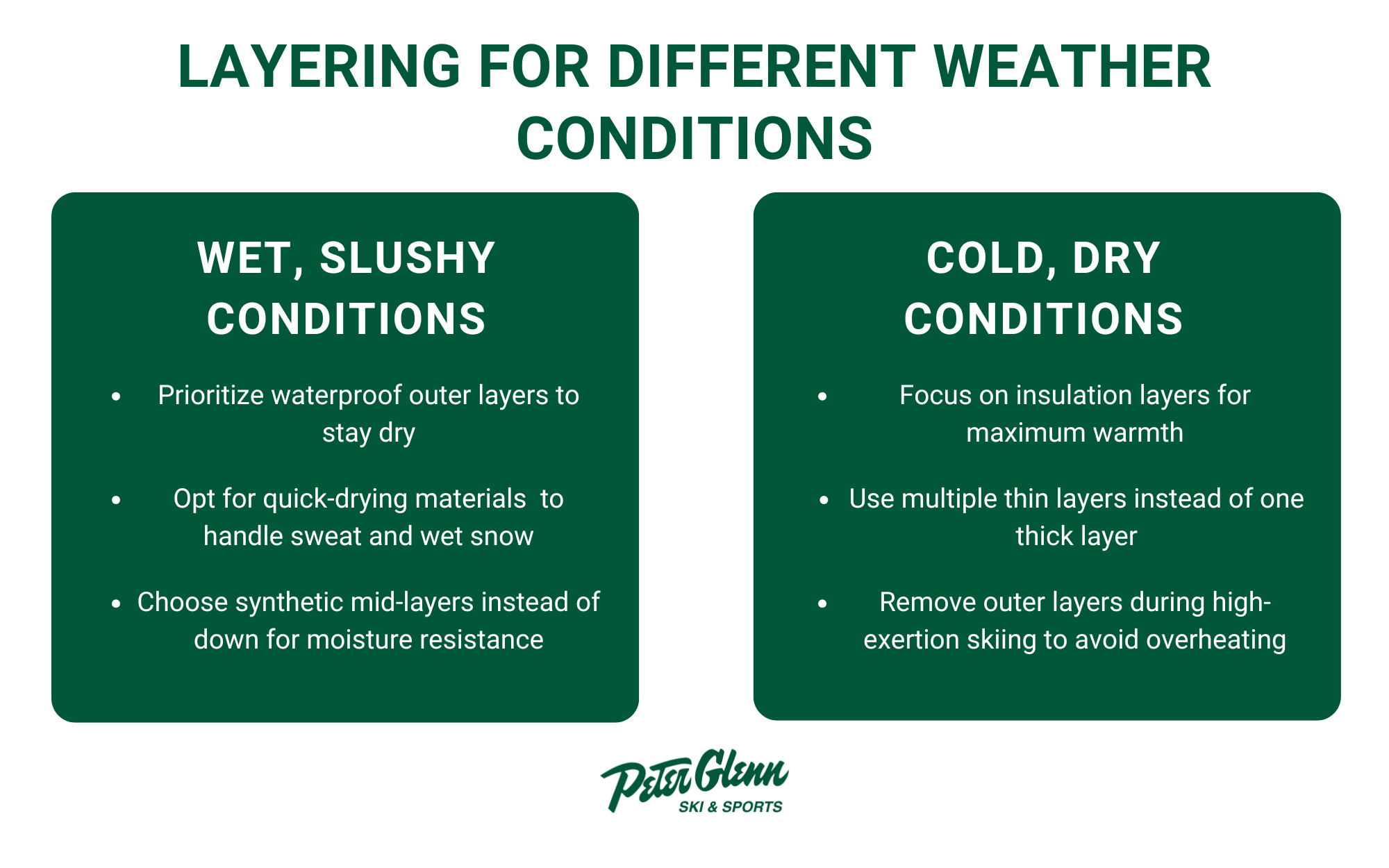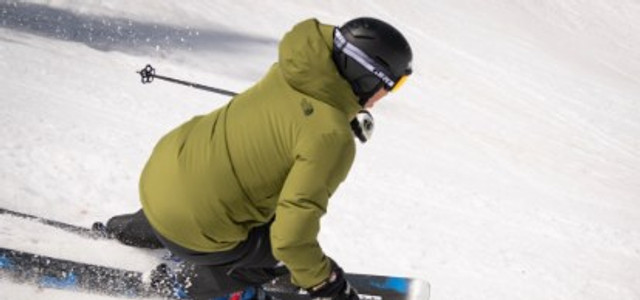How to Layer for Skiing to Stay Warm and Comfortable on the Slopes
Posted by Peter Glenn Staff on Sep 22nd 2025
Table of Contents
At a Glance: Proper ski layering uses a three-layer system to manage temperature and moisture during varying weather conditions and activity levels on the slopes. The base layer wicks sweat away from your skin, the mid layer (down or synthetic insulation) traps warm air for insulation, and the outer shell layer provides waterproof protection from wind, snow, and precipitation.
Proper layering is the foundation of comfortable and safe skiing, making the difference between an enjoyable day on the mountain and a miserable experience that ends early. Ski layering must account for extreme temperature variations, intense physical activity, and changing weather conditions that can shift dramatically throughout a single day on the slopes.
Effective layering centers on temperature regulation and moisture management. As you ski, your body generates significant heat through physical exertion and to maintain a steady body temperature in colder weather, causing you to sweat. Without proper moisture management, this sweat quickly becomes a liability when you stop for breaks or encounter wind.
The three-layer system provides a proven framework for managing these demands. Each layer serves a specific function: the base layer manages moisture, the mid-layer provides insulation, and the outer layer protects against wind, snow, and precipitation.

Understanding the Three-Layer System
Base Layer (Moisture Management)
The base layer serves as your skin's interface with the layering system, with its primary function being moisture management through wicking sweat away from your skin. This layer must transport perspiration from your body to outer layers where it can evaporate. Base layers should fit snugly against your skin without restricting movement or creating pressure points.
Base Layer Materials
Merino wool offers natural odor resistance, excellent body temperature regulation, and maintains insulating properties even when damp. Synthetic materials like polyester and nylon blends provide superior durability, faster drying times, and often cost less than wool options. Many synthetic base layers incorporate antimicrobial treatments to reduce odor buildup.
Mid Layer (Insulation)
The insulating layer traps warm air close to your body while allowing moisture from the base layer to continue moving outward. The middle layer provides the bulk of your warmth and should be easily adjustable as temperature and activity levels change. Lightweight insulation works well for milder days or high-exertion skiing, while heavyweight options suit extremely cold weather or lift-served skiing.
Mid Layer Materials
Material options center around the choice between down and synthetic insulation. Down offers superior warmth-to-weight ratios and excellent compressibility, ideal for cold, dry conditions. However, down loses insulating properties when wet and takes longer to dry. Synthetic insulation maintains warmth when damp, dries quickly, and typically costs less than down, though it's generally bulkier.
Outer Shell Layer (Weather Protection)
The outer layer provides critical protection from wind, snow, and moisture while allowing perspiration to escape from inner layers. This layer must balance waterproof protection with breathability to prevent overheating during active skiing.

Choosing the Right Base Layer
Base layers typically consist of tops, bottoms, thermal leggings, and paired sets meant to be worn underneath the rest of your ski outfit.
Material Selection
Fabric weight options for base layers range from lightweight for mild conditions, to midweight for typical skiing, to heavyweight for extremely cold conditions. Many skiers find midweight options provide the best balance of warmth and versatility. Avoid fabrics like cotton that lose insulating properties when wet.
Merino Wool
Merino wool base layers excel in odor resistance and temperature regulation, naturally managing bacterial growth during multi-day trips. Wool provides some insulation even when damp but typically costs more and requires careful washing.
Synthetic Fabric
Advantages to using synthetic fabric include superior durability, faster drying times, and easier care requirements. Polyester and nylon blends often incorporate stretch fibers that improve mobility during active skiing while costing significantly less than merino wool.
Fit and Comfort
Proper sizing ensures optimal moisture wicking while preventing restriction. Pay particular attention to frequently moving areas like shoulders, elbows, and knees, ensuring adequate stretch and articulation. Flat or offset seams reduce chafing and pressure points, particularly important for areas contacting ski boots, helmets, or backpack straps.
Mid Layer Options
Mid layers often consist of fleece tops and bottoms, turtlenecks, and vests that are worn in between base layers and outer shells.
Fleece and Synthetic Insulation
Polyester fleece jackets provide reliable warmth, easy care, and affordability. Fleece maintains insulating properties when damp and dries quickly, but offers limited wind resistance and can be bulky. Jackets and vests with synthetic fills utilize polyester insulation that mimics down's loft while maintaining performance in wet conditions.
Down Insulation
Down fill power ratings indicate quality and loft capability, with higher numbers representing superior warmth-to-weight ratios. Packability makes down insulation attractive for backcountry skiing, where space and weight matter. However, once wet, down loses virtually all insulating capability and takes considerable time to dry, making it less suitable for wet spring conditions.
Alternative Options
- Softshell Ski Jackets: These serve dual roles as both mid-layers and outer layers in mild conditions, combining stretch fabric, wind resistance, and water resistance.
- Insulated Vests: These focus warmth on the core while allowing unrestricted arm movement and reducing bulk under shell jackets.
Outer Layer Selection
Outer layers typically consist of ski jackets and ski jackets. These provide the final line of protection against cold temperatures and harsh weather conditions on the slopes
Waterproof Ratings
Understanding waterproof ratings helps match jackets to expected conditions.
- Moderate Precipitation: 10,000mm
- Heavy Snow & Rain: 15,000-20,000mm
- Severe Weather: Above 20,000mm (these may be unnecessary for typical resort skiing)
Outer Layer Features
- Powder Skirts: Snap or hook connections to ski pants provide extra protection from snow and wind.
- Ventilation: High-quality systems include storm flaps and water-resistant zippers.
- Helmet-Compatible Hoods: These should fit comfortably over helmets without restricting vision and have adjustment systems that work with gloves.

Layering for Different Conditions
Cold, Dry Conditions
Emphasize insulation layers when temperatures drop significantly. Multiple thin layers often provide better temperature regulation than single thick layers. Outer layers should be removed before high-exertion activities.
Wet, Slushy Conditions
Prioritize waterproof protection when dealing with wet snow, rain, or spring conditions. Consider synthetic insulation over down for mid-layers. Quick-drying materials throughout your system help manage moisture from external sources and perspiration.
Variable Weather
Pack removable mid-layers that can be easily stored. Modular systems with zip-in liners or removable hoods provide flexibility in warmer conditions. Packable options like lightweight down vests provide backup warmth without taking significant space.
Layering Accessories
Head and Neck Protection
- Helmet Liners: These provide crucial warmth under ski helmets while maintaining moisture management.
- Neck Gaiters & Balaclavas: These protect exposed skin while providing adjustable coverage.
Hand and Foot Warmth
Glove layering systems combine liner gloves with outer shells for maximum versatility. For socks, focus on moisture management and cushioning rather than warmth, as ski boots provide most insulation. Avoid cotton socks that retain moisture and cause cold feet.
Common Layering Mistakes to Avoid
Overdressing & Overheating
Address early warning signs of heat exhaustion like excessive sweating or feeling flushed immediately by removing layers or opening ventilation zips. Insulation layers should also be removed before high-energy activities.
Material and Fit Errors
Avoid cotton clothing, which retains moisture and loses insulating properties when wet. Make sure that tight layers restrict circulation and movement, while loose layers create air gaps that reduce efficiency.
Find Base Layers, Mid Layers, Outer Layers, and More Ski Clothing at Peter Glenn
Understanding proper layering ensures comfort, safety, and enjoyment on the mountain. Start with basic pieces and build your system over time, focusing on versatile items that work across multiple conditions and activity levels.
At Peter Glenn, we carry base layers, mid layers, ski jackets, ski pants, and more ski gear for men, women, and children. We carry high-performance ski clothes from top brands that are equipped with features that meet your needs and personal preferences. View our full ski collection to find all the equipment you need for the slopes.



